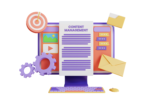The Ultimate Guide to Account-Based Marketing (ABM): Precision Targeting for B2B Success
Account-Based Marketing (ABM) has emerged as a game-changer in the B2B marketing landscape, offering a more focused and personalized approach to attracting and engaging high-value accounts. This comprehensive guide will walk you through the ins and outs of ABM, from understanding its core principles to implementing effective strategies and measuring your ROI.
What is Account-Based Marketing (ABM)?
ABM is a strategic B2B marketing approach that focuses on treating individual accounts as markets in their own right. Instead of casting a wide net and hoping for the best, ABM concentrates your resources on a select group of high-value target accounts. By tailoring your marketing and sales efforts to each account’s specific needs and interests, you can increase engagement, build stronger relationships, and ultimately drive more revenue.
Why ABM is a Game-Changer for B2B Marketers
ABM offers numerous benefits compared to traditional marketing approaches:
- Higher ROI: By focusing on high-value accounts, you can maximize your return on investment and allocate your resources more effectively.
- Shorter sales cycles: Personalized outreach and targeted messaging can accelerate the sales process and shorten the time it takes to close deals.
- Improved customer relationships: ABM fosters deeper relationships with your most valuable customers, increasing customer satisfaction and loyalty.
- Increased alignment between sales and marketing: ABM requires close collaboration between sales and marketing teams, ensuring that everyone is working towards the same goals.
Implementing Your ABM Strategy: A Step-by-Step Guide
- Identify Your Target Accounts: Start by defining your ideal customer profile (ICP) and identifying the accounts that fit this profile. Consider factors like industry, company size, revenue, and potential lifetime value.
- Develop Personalized Buyer Personas: Create detailed personas for each decision-maker within your target accounts. This will help you tailor your messaging and content to their specific needs and interests.
- Create Targeted Content: Develop high-quality content that addresses the pain points and challenges of your target accounts. This could include blog posts, whitepapers, ebooks, webinars, or even personalized videos.
- Personalize Your Outreach: Tailor your outreach efforts to each individual account. Use personalized emails, direct mail, social media interactions, and even phone calls to connect with decision-makers on a personal level.
- Leverage Account-Specific Advertising: Utilize targeted advertising platforms like LinkedIn and Facebook to deliver personalized ads to decision-makers within your target accounts.
- Measure Your ROI: Track key metrics like engagement rates, pipeline value, and revenue generated from your ABM campaigns. This will help you assess the effectiveness of your strategy and make data-driven adjustments as needed.
Measuring Your ABM Success
To ensure your ABM efforts are paying off, it’s crucial to track and measure your results. Here are some key metrics to consider:
- Engagement Rate: Track how often your target accounts interact with your content and outreach efforts.
- Pipeline Value: Measure the total value of deals influenced by your ABM campaigns.
- Customer Lifetime Value (CLTV): Assess the long-term value of your ABM-acquired customers.
- Return on Investment (ROI): Calculate the financial return on your ABM investment.
ABM Best Practices
- Align Your Sales and Marketing Teams: Ensure that your sales and marketing teams are working together seamlessly to execute your ABM strategy.
- Invest in the Right Tools: Utilize ABM platforms and tools to streamline your efforts and automate repetitive tasks.
- Focus on Quality Over Quantity: Prioritize a smaller number of high-value accounts rather than trying to target too many.
- Personalize, Personalize, Personalize: Tailor your messaging, content, and outreach to the specific needs and interests of each individual account.
- Continuously Measure and Optimize: Track your results and make data-driven adjustments to your strategy to ensure ongoing success.
Conclusion
Account-Based Marketing is a powerful strategy that can help B2B marketers achieve remarkable results. By adopting a targeted, personalized approach, you can build stronger relationships with your most valuable customers and drive significant revenue growth. With this comprehensive guide, you now have the knowledge and tools to implement your own successful ABM strategy.






